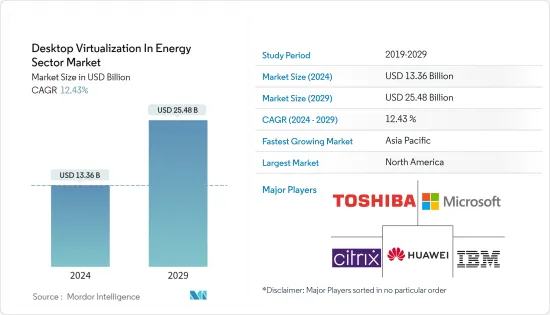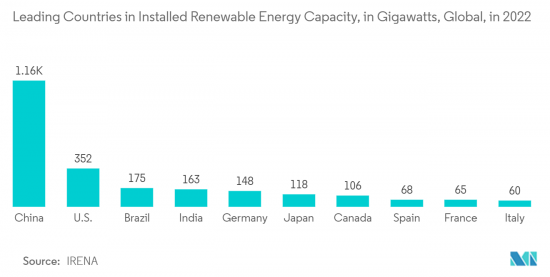 |
市场调查报告书
商品编码
1403091
能源产业虚拟桌面-市场占有率分析、产业趋势与统计、2024-2029 年成长预测Desktop Virtualization In Energy Sector - Market Share Analysis, Industry Trends & Statistics, Growth Forecasts 2024 - 2029 |
||||||
※ 本网页内容可能与最新版本有所差异。详细情况请与我们联繫。
预计2024年能源领域虚拟桌面市场规模为133.6亿美元,2029年将达254.8亿美元,复合年增长率预估为12.43%。

在能源领域,基础设施经常受到远端控制和监控。虚拟桌面使员工能够安全地远端存取关键系统和资料,从而提高业务效率。
主要亮点
- 随着能源需求的增加,能源公司被要求降低营运成本并简化业务流程。透过将桌面环境和资料集中在安全伺服器上,虚拟桌面可以增强资料安全性和合规性。
- 云端基础的虚拟桌面允许能源部门员工从任何有网路连接的地方存取虚拟桌面和关键应用程式。云端基础的解决方案提供强大的灾害復原功能。如果发生灾难或系统故障,能源公司可以从异地云端备份中快速恢復虚拟桌面环境和资料。
- 能源公司通常需要快速回应不断变化的业务需求。无论您是派遣团队前往远端钻井现场,还是让您的工程师从其他位置存取资料,虚拟桌面都可以让您弹性适应这些不断变化的环境。
- 基础设施的限制迫使工人从事传统工作。在能源领域,复杂且成熟的平台已经在本地部署,迁移到云端需要时间。对云端基础的员工资料的安全和隐私的担忧预计将阻碍市场成长。
- 基于人工智慧的劳动力分析解决方案、不断增加的劳动力资料来源以及对大量资料的存取预计将为市场参与企业创造利润丰厚的机会。自 COVID-19 以来,随着多家公司转向远距工作,市场一直备受关注。封锁和社交距离准则迫使许多公司立即做出必要的调整,并建立必要的电脑基础设施来支援远端工作人员。在能源领域,企业长期以来一直在使用虚拟桌面解决方案。
能源领域虚拟桌面市场趋势
云端部署模式部分预计将占据主要市场占有率
- 能源产业的各种公司正在使用云端运算来降低营运成本。云端託管的易于部署、可存取性和弹性预计将推动组织采用云端运算。云端部署包括DaaS(桌面即服务)、WaaS(工作空间即服务)和SaaS(应用程式/软体即服务)等服务模式。虚拟桌面作为云端网路上的服务提供,所有运算和支援基础设施均由服务供应商在云端部署中託管。
- 透过云端进行的应用程式串流在能源产业越来越受欢迎,许多公司选择独立的应用程式服务。云端在能源领域受到青睐,因为它提供了更好的可扩展性、资料管理和成本节约。
- 根据国际可再生能源机构的数据,2022年全球水力发电装置容量达到1,393吉瓦(GW),较2021年成长2.19%。由于未来水力发电发电工程和技术进步,水电装置容量预计将增加。此外,2022年引进可再生能源的领先国家是中国、美国和巴西。在可再生能源装置方面,中国以约1,161吉瓦位居第一。
- 云端部署提供了满足由于水力发电容量增加而增加的运算需求所需的弹性和可扩展性。这使得组织可以根据需要配置和取消配置虚拟桌面和资源,以适应计划的成长。
- 虚拟桌面的云端部署支援远端存取关键应用程式和资料。工程师可以在任何有网路连接的地方进行操作,管理人员可以安全地监控和管理水力发电计划,从而提高业务效率并减少对现场人员的需求。此外,2022年8月,印度政府宣布在尼泊尔开发两个水力发电发电工程,分别为西塞蒂发电工程和塞蒂河水力发电发电工程。这些计划的总营运成本预计约为24亿美元。这些新兴市场的开拓为能源领域虚拟桌面市场的云端部署提供了型态。

亚太地区预计将占据主要市场占有率
- 亚太地区公司早期采用新技术并投资于能源领域是全球主导地位的关键驱动力。主要云端服务供应商在亚太地区云端基础的虚拟桌面采用的成长中发挥着重要作用。亚太地区的能源公司透过由智慧电网技术等新产品和服务支援的复杂基础设施网路来传输、分配和储存能源。
- 截至2022年,中国在可再生能源部署方面处于世界领先地位。 2022年可再生能源发电总量将达到1,160.8GW,与前一年同期比较增长约13.4%。水力发电、太阳能和风电是该国主要的再生能源来源。
- 印度政府设定了2022年安装175GW可再生能源装置的目标,其中包括100GW太阳能发电、60GW风电、10GW生物发电和5GW小型水力。此外,印度新能源和可再生能源部预计到2022年将在可再生能源、电动车、太阳能设备製造和生态氢能方面投资150亿美元。
- 此外,印度政府正在大力投资可再生能源以减少碳排放,实施各种大型永续电力计划,并专注于发展绿色能源。截至 2021 年,印度可再生能源装置容量已达到 147 吉瓦,该国的目标是到 2030 年可再生能源装置容量约为 450 吉瓦 (GW)。
- 日本政府也计划在2030年将二氧化碳排放减少50%,到2050年实现碳中和。 2022年9月,EcoPower Investment (GPI) 选择GE再生能源作为位于青森县西津轻区深浦町的深浦风力发电厂的营运商。该计划将包括 19 台 GE 4.2-117 陆上风力涡轮机,也是 GE 在日本的第三个计划。
能源领域的虚拟桌面虚拟化
能源领域的虚拟桌面市场较为分散,主要参与者包括思杰系统公司、东芝公司、IBM公司、华为科技公司和微软公司。市场参与企业正在采取联盟和收购等策略来加强其产品供应并获得永续的竞争优势。
2023 年 8 月,戴尔科技集团宣布透过虚拟架构支援向可再生能源的转变。经过戴尔验证的 Energy Edge 设计可为动态且多样化的可再生能源环境中的电网营运商提供安全性和控制力。为了满足这些需求,变电站营运商越来越多地使用虚拟来实现自动化、控制和管理。虚拟平台提供了快速响应不稳定和不断发展的网格中的新挑战的弹性。
2022 年 5 月,Citrix 的 DaaS(桌面即服务)平台与云端供应商集成,让企业可以选择託管其虚拟桌面产品。 Citrix Systems, Inc. 与 Google Cloud 合作,让已在本地使用 Citrix VDI 技术的公司更轻鬆地切换到 Google Cloud 上託管的 Citrix DaaS。
其他福利:
- Excel 格式的市场预测 (ME) 表
- 3 个月分析师支持
目录
第一章简介
- 研究假设和市场定义
- 调查范围
第二章调查方法
第三章执行摘要
第四章市场洞察
- 市场概况
- 价值链分析
- 产业吸引力-波特五力分析
- 新进入者的威胁
- 买家/消费者的议价能力
- 供应商的议价能力
- 替代品的威胁
- 竞争公司之间的敌对关係
第五章市场动态
- 市场驱动因素
- 云端运算的进步和远端存取的需求推动市场成长
- 市场抑制因素
- 基础设施限制阻碍市场扩张
第六章市场区隔
- 透过桌面交付平台
- 託管虚拟桌面 (HVD)
- 託管共用桌面 (HSD)
- 依实施型态
- 本地
- 云
- 按地区
- 北美洲
- 欧洲
- 亚太地区
- 世界其他地区 中东/非洲
第七章竞争形势
- 公司简介
- Citrix Systems Inc.
- Toshiba Corporation
- IBM Corporation
- Huawei Technologies Co. Ltd
- Microsoft Corporation
- Parallels International GmbH
- Dell Inc.
- NComputing
- Ericom Software Inc.
- Vmware Inc.
第八章投资分析
第九章 市场机会及未来趋势

The Desktop Virtualization In Energy Sector Market size is estimated at USD 13.36 billion in 2024, and is expected to reach USD 25.48 billion by 2029, growing at a CAGR of 12.43% during the forecast period (2024-2029).
The energy sector often involves remote operations and monitoring of infrastructure. Desktop virtualization allows employees to access critical systems and data securely from remote locations, improving operational efficiency.
Key Highlights
- The increasing energy demand necessitates energy companies to reduce operating costs and streamline business processes. By centralizing desktop environments and data on secure servers, desktop virtualization can enhance data security and compliance, which is crucial in the energy sector due to sensitive information and regulatory requirements.
- Cloud-based desktop virtualization allows energy sector employees to access their virtual desktops and critical applications from anywhere with an Internet connection. Cloud-based solutions offer robust disaster recovery capabilities. In a disaster or system failure, energy companies can quickly recover their virtual desktop environments and data from off-site cloud backups.
- Energy companies often need to respond quickly to changing operational requirements. Whether deploying a team to a remote drilling site or providing engineers with access to data from a different location, desktop virtualization offers the flexibility to adapt to these changing circumstances.
- Infrastructural constraints compel the workers to work traditionally. The energy sector already has complex and established platforms that are on-premise, and moving them to the cloud is time-consuming. Concerns about the security and privacy of cloud-based worker data are expected to hamper the market growth.
- AI-based workforce analytics solutions, an increasing number of workforce data sources, and the accessibility of vast data are expected to create lucrative opportunities for the players in the market. The market has been brought to focus since COVID-19 because various businesses have moved to remote working. The lockdown and social distancing guidelines forced many businesses to make the necessary adjustments immediately and build the computer infrastructure needed to support their remote workers. Businesses have been using desktop virtualization solutions in the energy sector for a long time.
Desktop Virtualization In Energy Sector Market Trends
Cloud Deployment Mode Segment is Expected to Hold Significant Market Share
- Various energy sector organizations are using cloud computing to reduce businesses' operational costs. Easy implementation, accessibility, and flexibility of cloud hosting are expected to drive organizations' adoption of cloud computing. Cloud deployment includes service models, such as Desktop-as-a-Service (DaaS), Workspace-as-a-Service (WaaS), and Application/Software-as-a-Service (SaaS). Desktop virtualization is offered as a service over cloud networks, with all computing and supporting infrastructure hosted on the service provider's end in the cloud deployment mode, which makes the migration of data between working environments easy.
- Application streaming over the cloud is gaining popularity in the energy sector industry, with many businesses choosing standalone application services. Cloud is preferred across energy sector industries, providing better scalability, data management, and cost savings.
- According to the International Renewable Energy Agency, in 2022, the global hydropower installed capacity reached 1393 gigawatts (GW), representing a rise of 2.19% compared to 2021. The hydropower installed capacity is expected to grow with the upcoming hydro projects and technological advancements. Furthermore, the leading countries for installed renewable energy in 2022 were China, the United States, and Brazil. China was in first place in renewable energy installations, with a capacity of around 1,161 gigawatts.
- Cloud deployment offers the flexibility and scalability required to accommodate the increasing computing demands of expanding hydropower capacity. It allows organizations to provision and de-provision virtual desktops and resources as needed, aligning with the project's growth.
- Cloud deployment of virtual desktops enables remote access to critical applications and data. Engineers operate, and managers can securely monitor and manage hydro projects from anywhere with an internet connection, improving operational efficiency and reducing the need for on-site personnel. Moreover, in August 2022, the Government of India announced the development of two hydropower projects in Nepal, namely the West Seti Hydropower Project and the Seti River Hydropower Project. The total cost of these projects is expected to be around USD 2.4 billion. Such developments provide opportunities for the cloud deployment mode of the desktop virtualization market in the energy sector.

Asia Pacific is Expected to Hold Significant Market Share
- Organizations in the Asia Pacific region companies early adoption of new technologies and investments in energy sectors are the primary driving force behind global dominance. Large cloud service providers play a significant role in the region's growth of cloud-based desktop virtualization deployment. The energy companies in the Asia Pacific region further transmit, distribute, and store energy through complex infrastructure networks supported by emerging products and services such as smart grid technologies.
- As of 2022, China is the global leader in renewable energy deployment. The country's total renewable energy capacity reached 1160.8 GW in 2022, representing an increase of approximately 13.4 percent compared to the previous year. Hydropower, solar, and wind are the major renewable energy sources in the country.
- The Government of India has set a target of installing 175 GW of renewable energy capacity by FY 2022, including 100 GW from solar, 60 GW from wind, 10 GW from bio-power, and 5 GW from small hydropower. Moreover, the Indian Ministry for New and Renewable Energy expects investment of USD 15 billion in renewable energy, electric vehicles, manufacturing of solar equipment, and green hydrogen in 2022.
- In addition, the Government of India is investing heavily in renewable energy to reduce carbon emissions, undertaking various large-scale sustainable power projects, and promoting green energy heavily. As of 2021, India's installed renewable energy capacity stood at 147 GW, and the country is targeting about 450 Gigawatt (GW) of installed renewable energy capacity by 2030, which will directly aid the market.
- Japan's government has also targeted reducing carbon emissions to 50 percent by 2030 and achieving carbon neutrality by 2050. In September 2022, Green Power Investment (GPI) chose GE Renewable Energy as the provider for the Fukaura Wind Farm in Fukaura Town, Nishi Tsugaru District, Aomori Prefecture, Japan. The project, which will include 19 units of GE's 4.2-117 onshore wind turbines, is GE's third in Japan.
Desktop Virtualization In Energy Sector Industry Overview
The desktop virtualization market in the energy sector is fragmented, with the presence of major players like Citrix Systems Inc., Toshiba Corporation, IBM Corporation, Huawei Technologies Co. Ltd, and Microsoft Corporation. Players in the market are adopting strategies such as partnerships and acquisitions to enhance their product offerings and gain sustainable competitive advantage.
In August 2023, Dell Technologies announced its support for the shift to renewable energy with virtualized architecture. Dell-validated design for Energy Edge offers grid operators security and control in dynamic, diverse renewable energy environments. To meet these demands, substation operators increasingly use virtualization for automation, control, and management. A virtualized platform provides the flexibility to quickly respond to new challenges in a volatile, evolving grid.
In May 2022 - Citrix's Desktop as a Service (Daas) platform collaborated with cloud providers, giving businesses a choice of host for their virtual desktop products. Citrix Systems, Inc. partnered with Google Cloud and believed that this would make it simpler for businesses already utilizing Citrix VDI technology on-premises to switch to Citrix DaaS hosted on Google Cloud.
Additional Benefits:
- The market estimate (ME) sheet in Excel format
- 3 months of analyst support
TABLE OF CONTENTS
1 INTRODUCTION
- 1.1 Study Assumptions and Market Defnition
- 1.2 Scope of the Study
2 RESEARCH METHODOLOGY
3 EXECUTIVE SUMMARY
4 MARKET INSIGHTS
- 4.1 Market Overview
- 4.2 Value Chain Analysis
- 4.3 Industry Attractiveness - Porter's Five Forces Analysis
- 4.3.1 Threat of New Entrants
- 4.3.2 Bargaining Power of Buyers/Consumers
- 4.3.3 Bargaining Power of Suppliers
- 4.3.4 Threat of Substitute Products
- 4.3.5 Intensity of Competitive Rivalry
5 MARKET DYNAMICS
- 5.1 Market Drivers
- 5.1.1 Growing Adoption of Cloud and Need for Remote Accessibility is Driving the Market Growth
- 5.2 Market Restraints
- 5.2.1 Infrastructural Constraints is Discouraging the Market Expansion
6 MARKET SEGMENTATION
- 6.1 By Desktop Delivery Platform
- 6.1.1 Hosted Virtual Desktop (HVD)
- 6.1.2 Hosted Shared Desktop (HSD)
- 6.2 By Deployment Mode
- 6.2.1 On-Premise
- 6.2.2 Cloud
- 6.3 By Geography
- 6.3.1 North America
- 6.3.2 Europe
- 6.3.3 Asia Pacific
- 6.3.4 Rest of the World
7 COMPETITIVE LANDSCAPE
- 7.1 Company Profiles
- 7.1.1 Citrix Systems Inc.
- 7.1.2 Toshiba Corporation
- 7.1.3 IBM Corporation
- 7.1.4 Huawei Technologies Co. Ltd
- 7.1.5 Microsoft Corporation
- 7.1.6 Parallels International GmbH
- 7.1.7 Dell Inc.
- 7.1.8 NComputing
- 7.1.9 Ericom Software Inc.
- 7.1.10 Vmware Inc.













